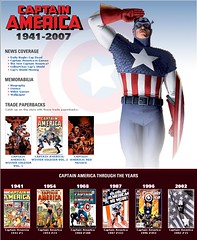Home » Ponderings (Page 5)
Category Archives: Ponderings
I Jaikued today … I don’t think I shall again.
I tried Jaiku today since it’s been discussed a lot recently as the ‘other’ Twitter (even though Jaiku was around first, I think).
First impressions of Jaiku – a lot more tools, more fleshed out, I like the idea of comment threads on individual messages, it’s less about popularity per se, and more about a small tight-knit group (I think). The recent explosion of interest and use of Twitter seems to have people trying Jaiku as well, but from my few hours of use, the massive influx of users has left Jaiku with more speed problems than Twitter’s recent scaling and capacity issues.
However, the appeal of Twitter for me is its simplicity … it has very few tools and the posts (Twits) are primarily self-contained. The ‘@’ reponding has evolved socially, but I don’t imagine it’ll grow to get all that complicated.
More to the point, for me, Twitter is a sometimes food and I like my procrastination (or ‘continual partial prescence’ if you must) simple and no fuss.
Apparently I’m in Vogue
 You’ll forgive the title to this post, I’ve never been able to let a good pun go and I doubt I’ll ever be able to use that one again. It’s true, though: I was interviewed about a month ago by Cathrin Shaer, a New Zealand-based writer for Vogue Australia who was writing a piece on life online. She was trying to do an awful lot in one article (talking about MySpace, Flickr, YouTube, Second Life, etc.) but somehow my name came up and I ended up talking with her for almost an hour about the complexities of interaction in different online modes. Clearly the bit that stuck was about Second Life. Here is the snippet from that interview which appeared today in ‘A life less ordinary’ (Vogue Australia, May 2007):
You’ll forgive the title to this post, I’ve never been able to let a good pun go and I doubt I’ll ever be able to use that one again. It’s true, though: I was interviewed about a month ago by Cathrin Shaer, a New Zealand-based writer for Vogue Australia who was writing a piece on life online. She was trying to do an awful lot in one article (talking about MySpace, Flickr, YouTube, Second Life, etc.) but somehow my name came up and I ended up talking with her for almost an hour about the complexities of interaction in different online modes. Clearly the bit that stuck was about Second Life. Here is the snippet from that interview which appeared today in ‘A life less ordinary’ (Vogue Australia, May 2007):
Tama Leaver, a lecturer at The University of Western Australia whose research interests include exploring how humans interact with technology, has used Second Life for business meetings: “Most of the people working in my field are spread across the globe. I’ve participated in teleconferencing, but it’s better of have a conference in Second Life because you’re all in a room together, rather than just disembodied voices.” Apparently, even if you’re meeting with a bunch of serious academics, it doesn’t matter if you look like a cartoon character. “There’s a great parallel in animated films,” Leaver explains. “We understand what’s going on in an animated character’s face — most people understanding what Shrek was saying.”
Not exactly mind-blowing stuff on my part. Also, I suspect there are a few sentences Shaer could have left in since there was somewhat more space and substance between talking about academic discussion in Second Life and Shrek (for the record, I’ve never met anyone online or offline who looks like Shrek – while the facial features might be there, no one I’ve met was actually green). That said, it’s interesting to see interest in social software spreading as far as Vogue. (Although I was a little surprised that they didn’t use any Second Life screenshots for illustration – and what they did use seemed like a bad high school art collage – perhaps the Vogue graphics people didn’t actually make it in-world).
‘Ghosts of blogging’?
In light of the recent tragic chatroom/webcam suicide, I wondered what an article “Ghosts of blogging haunt net cemetery” might have to say about the role of blogs after a blogger’s life. Alas, this has to be one of the worst, ignorant, mainstream-media puff pieces in a long time:
In the latest entry on her personal weblog, Lindsay Lohan, the hard-partying Hollywood actress, was in characteristically bubbly form. “Hey guys, I’m soooo sooo sorry I haven’t written in a while!!” she wrote. She was heading off to New York for two days of photo-shoots, then to Toronto in Canada for a week of filming, then back to Los Angeles again. The entry ended: “I just wanted to check in, I’ll try and write more … xx LL.” It has been a long wait for any Lohan fans who may be hoping for an update. That entry was posted on October 15, 2003.
Lohan’s blog has since taken its place in the internet’s fastest-growing graveyard – of an estimated 200 million blogs that have been started, then abandoned.
The extraordinary failure rate of online diaries and claims that interest in blogging will soon begin a precipitous slide are sparking an intriguing debate about the future of self-expression on the internet and whether blogs, once seen as revolutionary, are destined to become a footnote in the history of computing.
To the embarrassment of millions of internet users – from Hollywood celebrities such as Lohan, Melanie Griffith and Barbra Streisand to countless ordinary parents, workers and would-be poets – the evidence of failed diary-keeping cannot be easily erased from search engines that continue to provide links to blogs that have lain dormant for years.
This article clearly commits many of the most juvenile mistakes about writing regarding blogs — no, not all blogs are online diaries; no, celebrities who blog are no more typical of bloggers than they are of people — but even a journalist who has never read a blog should feel a little silly making the leap to describing the ‘extraordinary failure rate’ of blogs. Or are blogs, unlike regular diaries, or pretty much any other form of narrative or writing – the only form which is supposed to be endless? Blogs have been around for a long time and, like most other things, many blogs have had their natural lifespan, dictated by the purpose for which they were originally constructed. Some blogs are used in education – and thus often have a lifespan of a semester or two; some are issue-driven and may end when that issue is resolved; indeed some are diaries, but like hardcopy diaries, they tend to get left behind after a few years.
All of those gripes aside, the article did make two good points: firstly, that the exponential rise of blogging has to slow soon (because exponential means, quite literally, that there would have to be more blogs than people within a few years at recent growth rates); and secondly that citizens of a digital culture may be shifting their focus to other platforms like YouTube and MySpace. That’s not really an argument about the death of blogging, though – it’s more testimony to the maturing of the world of social software in that many more options available for those many networks of interest and friendship which life online can facilitate.
Of course, I wonder why no one writes about how many MySpace profiles are abandoned? (Far be it from me to points out that the same folk that own MySpace own The Australian).
I guess one has to ask The Australian, if blogs are on the decline, why does your blog section keep growing?
When Captain America Drops His Mighty Shield
“It’s a hell of a time for him to go. We really need him now.”
– Joe Simon (co-creator of Captain America)
While Peter Parker and his alter-ego Spider-Man have long been the iconic representation of the layperson (or everyperson) — the ordinary guy who, by accident rather than intent, became a hero — Captain America, in contrast, has always been stood for the ideals of the American dream and the democratic system at its heart. Captain America was created in the midst of World War II, and has fought the Nazis, communism and many other threats to the ‘American way of life’. Given his role, the demise of such a figure is more than a ploy to sell comic books (although it is that, too); it’s a commentary on the upheaval at the heart of what being American actually means. As Joe Simon, Cap’s co-creator along with Jack Kirby, has stated in interviews on the back of Cap’s death: “It’s a hell of a time for him to go. We really need him now.”
In July last year I wrote about the parallels between Marvel’s Civil War storyline and the ‘War of Terror’, noting that the Civil War stories borrowed heavily both from September 11 and the related special-edition tributes done by various comic book publishers. The image of Captain America’s sorrow was used powerfully both in Marvel’s renderings of the ruins of the World Trade Centre Towers and the tragedy which kick-started Marvel’s Civil War. During the past months, I was also impressed by the directness with which the Civil War stories appeared to address the situation in Guantanamo Bay when one of Marvel’s more jovial characters, Speedball – or Robert Baldwin – was arrested as an “an unregistered combatant” and locked away in a prison which seemed to exist outside of legal jurisdiction. To some extent that critique continues beyond the conclusion of the Civil War storyline as Robert Baldwin has now backed down and accepted Registration and become a new ‘hero’ (in the broadest sense of the word) under the guise ‘Penance’, a self-hating hero, wracked by guilt about the deaths his team unwittingly caused, and whose powers emerge proportionally to the amount of pain he’s in (it’s hardly a shock, then, that Warren Ellis is penning Thunderbolts, which now features Penance in the team’s line-up).
[Image from Marvel’s Civil War: Frontline #10; click to enlarge.]
 After those impressive beginnings, I was completely stunned at how badly the Marvel wrapped up its Civil War run, with Cap seemingly surrendering on a revelation — that the war between heroes was hurting a lot of innocent people in its wake — so mundane it bordered on stupid. That said, when Cap was actually gunned down by an assassin in Captain America #25, I could see where the story was supposed to have gone (I still think, though, that his death should have occurred in the last issue of the Civil War story, not another tie-in edition, even Cap’s own book). Cap’s death has altered the Marvel Universe, with even Tony Stark (Iron Man) privately admitting that the Civil War wasn’t worth the death of one of Marvel’s greatest icons (in Civil War: The Confession, yet another Civil war spin-off). There has been a lot of press about Marvel killing off one its core characters, but I think these stories are best summed up by Damian Fowler writing in The Guardian‘s books blogs with these insightful thoughts on ‘Why Captain America had to die’:
After those impressive beginnings, I was completely stunned at how badly the Marvel wrapped up its Civil War run, with Cap seemingly surrendering on a revelation — that the war between heroes was hurting a lot of innocent people in its wake — so mundane it bordered on stupid. That said, when Cap was actually gunned down by an assassin in Captain America #25, I could see where the story was supposed to have gone (I still think, though, that his death should have occurred in the last issue of the Civil War story, not another tie-in edition, even Cap’s own book). Cap’s death has altered the Marvel Universe, with even Tony Stark (Iron Man) privately admitting that the Civil War wasn’t worth the death of one of Marvel’s greatest icons (in Civil War: The Confession, yet another Civil war spin-off). There has been a lot of press about Marvel killing off one its core characters, but I think these stories are best summed up by Damian Fowler writing in The Guardian‘s books blogs with these insightful thoughts on ‘Why Captain America had to die’:
Created by Marvel comics in 1941 to battle the Nazis, the massively-pumped “Cap” was first seen punching Hitler in the face. Nice work if you can get it. But last week the patriotic crusader was shot and killed by a sniper in the latest issue of the long-running comic book.
Over the years, Captain America’s storyline has always reflected American moods and attitudes. When he first showed up, he was a sentinel of liberty and the fight for right. He was a mirror of everything that America stood for during the second world war. He always fought relentlessly for values that the US held dear.
How times change. Now he’s very much dead, something that was confirmed by the president and publisher of Marvel Entertainment. The New York Times all but wrote an obituary for the man, albeit in the arts pages, dead at 66. But it’s a sign of the times.
His demise is so much more than a tragedy in Toontown, even as the comic-book geeks mourn his passing. […] Cap’s death is being seen, analysed and discussed through the prism of national politics as a damning indictment of George Bush’s America. Even the major American TV networks picked up on the story, cutting images of the war in Iraq with the comic book images.
The Marvel Universe post-Captain America is an unfamiliar place. It’s a Marvel Universe in tune with the US and the Western world more broadly; a West which invaded Iraq four years ago but has to bring any semblance of stability to the region. With Cap’s shield gathering dust, his ideological opposite, Iron Man (a weapons manufacturer and alcoholic as well as a superhero) is now in charge of Marvel’s registered super-hero fighting machine (with a team in every state of the US). Spider-man, who revealed his identity during the Civil War, is now part of a small but notable underground resistance, but is also desperately trying to deal with the death of family members. Captain America’s death hangs over the comic book world, and leaves lasting questions about the direction and politics of the world of Marvel and its heroes.
However, As Benari Poulten reminds us, Captain America has been dead before and Steve Rogers has been replaced as Cap in the past, so it’s unlikely that the iconic hero will be gone from the Marvel universe for good. That said, Marvel have enjoyed amazing press and attention in the wake of the assassination of one of their key heroes — Cap’s demise even made ‘the Word’ on The Colbert Report and Steven Colbert now has Cap’s shield in his trophy case — so if death is to carry any weight at all in mainstream comic books, the inevitable return will have to be handled carefully, not just commercially. Personally, I think Steve Rogers should stay dead now, I think his death was representative of many things, including changes in Marvel both as a comic book universe and as part of a multi-national company. That said, words by Peter David about the X-Men titles are increasingly true about all comic book characters: “Mutant heaven has no pearly gates, only revolving doors” (X-Factor #70). If he can’t stay dead, Marvel, please earn any return of Captain America or one of your most striking characters will be diluted beyond a meaningful existence.
(Yes, the title of this post is a shameless adaptation of the Cap cartoon theme song; it’s also an homage to Henry Jenkins’ brilliant essay ‘Captain America Sheds His Might Tears: Comics and September 11’ which appeared in Daniel J. Sherman and Terry Nardin (eds), Terror, Culture, Politics: Rethinking 9/11, Indiana UP, 2006.)
It’s a Small World After All: From Wired’s Minifesto to the Twitterati
Apparently small is the new black. This month’s Wired Magazine contains a Minifesto, celebrating the coolness of all things mini, from meals to media:
Today, media snacking is a way of life. In the morning, we check news and tap out emails on our laptops. At work, we graze all day on videos and blogs. Back home, the giant HDTV is for 10-course feasting – say, an entire season of 24. In between are the morsels that fill those whenever minutes, as your mobile phone carrier calls them: a 30-second game on your Nintendo DS, a 60-second webisode on your cell, a three-minute podcast on your MP3 player.
From YouTube’s clip culture to Apple’s iTunes (not iAlbums), it seems for the time being smaller is, in fact, better! In the world of social software, the coolest and probably the smallest is Twitter, which allows users to post entries of no more than 140 characters, sent in from the web, IM or text message and being sent out via these same three platforms to your Twitter friends. Twitter has some impressive parents, including Evan Williams (who started Blogger before is was sold to Google) and the other Obvious folk. I’ve experimented with Twitter for the past few days, and I can see the appeal of its immediacy, and the fact that you really can’t take up much time with so little space to type! From the larger blogosphere, Jill Walker has been thinking about her Twittering in terms of blogging, noting similarities and differences:
…there’s something very satisfying about logging your days like that and seeing what others are up to. It’s a blog at a different scale than this one, in a way, very short posts, but far more frequent…
The logging aspect is quite addictive, and despite the brevity of posts, reading just a few Twitters seems to build quite an intimate picture of someone. Ross Mayfield in his post ‘Twitter Tips the Tuna’ gives this succinct explanation of Twitter:
Twitter, in a nutshell, is mobile social software that lets you broadcast and receive short messages with your social network. You can use it with SMS (sending a message to 40404), on the web or IM. A darn easy API has enabled other clients such as Twitterific for the Mac. Twitter is Continuous Partial Presence, mostly made up of mundane messages in answer to the question, “what are you doing?” A never-ending steam of presence messages prompts you to update your own. Messages are more ephemeral than IM presence — and posting is of a lower threshold, both because of ease and accessibility, and the informality of the medium.
I think that notion of ‘Continuous Partial Presence’ may very well be the core of Twitter. Mayfield goes on to argue that Twitter is peaking, with the uptake rate getting higher and higher, with everyone from Joi Ito to the BBC staking their claim as Twitterati. Indeed, as Steve Rubel notes, even John Edwards who is once again campaigning to be the Democrat candidate in the US presidential elections, is using Twitter to keep in touch with his supporters.
While there are probably a lot of people who’ll see Twitter as the icon of procrastination (and I can see their point!), Liz Lawley responds to criticisms of Twitter, pointing out that these ephemeral tidbits can actually be quite important:
The first criticizes the triviality of the content. But asking “who really cares about that kind of mindless trivia about your day” misses the whole point of presence. This isn’t about conveying complex theory–it’s about letting the people in your distributed network of family and friends have some sense of where you are and what you’re doing. And we crave this, I think. When I travel, the first thing I ask the kids on the phone when I call home is “what are you doing?” Not because I really care that much about the show on TV, or the homework they’re working on, but because I care about the rhythms and activities of their days. No, most people don’t care that I’m sitting in the airport at DCA, or watching a TV show with my husband. But the people who miss being able to share in day-to-day activity with me–family and close friends–do care.
The second type of criticism is that the last thing we need is more interruptions in our already discontinuous and partially attentive connected worlds. What’s interesting to me about Twitter, though, is that it actually reduces my craving to surf the web, ping people via IM, and cruise Facebook. I can keep a Twitter IM window open in the background, and check it occasionally just to see what people are up to. There’s no obligation to respond, which I typically feel when updates come from individuals via IM or email. Or I can just check my text messages or the web site when I feel like getting a big picture of what my friends are up to.
So, for Lawley, it would appear that everyone has their own Twitterati who are more likely to be family and friends than anyone else. Thanks once again to Steve Rubel, there’s now a basic Twitter Search, so if you’re not using it already, why not explore a little and decide who might be in your Twitterati? 😉 (And feel free to add me, if you like.)
Welcome to TamaLeaver dot Net!
I’ve been testing and tweaking this blog for almost a month now, so I thought it was time to declare Tama Leaver dot Net open for blogging business! In the coming months (or years … or maybe more) I’ll be writing here about my thoughts on digital culture (whatever that might mean). I’m very interested in the world of blogging per se, as well as social software more generally from podcasts to YouTube, del.icio,us, Flickr and so forth.
In my professional life I’m currently working as an Associate Lecturer (Higher Education Development) at the University of Western Australia’s Centre for the Advancement of Teaching and Learning, and have previous worked in both Communication Studies and English and Cultural Studies also at UWA.
This blog is the successor to Ponderance, my previous Blogger blog, so if you’re after something before March 2007, it’s probably archived there. I blogged at Ponderance for almost four years, but I decided to migrate here in order to use my own WordPress installation and customise everything more fully that Blogger could allow.
I thought I’d also use this welcome entry to signpost my other current activities and collections so they can be easily located if you were actually looking for something more specific:-
[X] My del.icio.us bookmarks – Each day at 8am Perth time (or 9am during daylight saving; midnight GMT) a post is automatically generated and appears here with a list of my annotated bookmarks from the previous 24 hours. To explore my full bookmark collection, either scroll down on the main blog page and there’s a clickable tagcloud (a list of the frequently used tags I’ve added to my bookmarks) or go to my del.icio.us page.
[X] My Flickr photos – My latest five photos posted to Flickr appear on the right sidebar under my blogroll or you can explore them all in my Flickr photographs.
[X] Tama’s eLearning Blog – Part of the wonderful edublogs.org network, this blog is focused on issues about issues about using technology, web2.0 and other ‘eLearning’ ideas as part of a range of learning and teaching tools and strategies in higher education. Occasionally I’ll cross-post items both here and to my eLearning blog, but for the most part my eLearning thoughts will be posted in my edublog.
[X] Tama Talks Blog – Which is part of the UWA postgraduate community social software system MyResearchSpace. The blog is written primarily for that community and explores why blogging matters to postgraduates.
(If you’re subscribed to the feed from my previous blog, Ponderance, I’ve automatically updated feedburner to re-direct the to the feed from Tama Leaver dot Net, which is replacing Ponderance. If you’re still confused, see Ponderance’s retirement announcement.)
Any questions or comments? 🙂 They’re always welcome.




